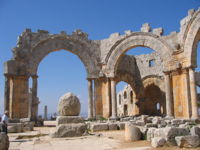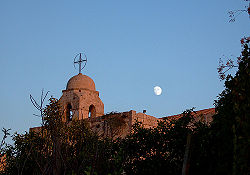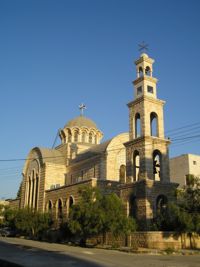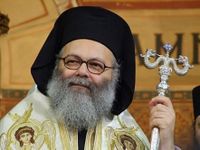Church of Antioch
| Greek Orthodox Patriarchate of Antioch and All the East | |
| Founder(s) | Apostles Peter and Paul |
| Autocephaly/Autonomy declared | Traditional |
| Autocephaly/Autonomy recognized | Traditional |
| Current primate | John X (Yazigi) |
| Headquarters | Damascus, Syria |
| Primary territory | Syria, Lebanon, Iran, Iraq, Kuwait, Saudi Arabia, Oman, UAE, parts of Turkey |
| Possessions abroad | United States, Canada, Central America, South America, Australia, New Zealand, Oceania, Great Britain, Western Europe |
| Liturgical language(s) | Arabic, Greek, English |
| Musical tradition | Byzantine Chant |
| Calendar | Revised Julian |
| Population estimate | 2 million |
| Official website | Church of Antioch |
The Church of Antioch is one of the five patriarchates (i.e., the Pentarchy) that constituted the one, holy, catholic, and apostolic Church before the schism between Rome and Antioch in 1098 and between Rome and the other patriarchates at around the same general period. Today it is one of the autocephalous Orthodox churches. In English translations of official documents, the Church of Antioch refers to itself as the Greek Orthodox Patriarchate of Antioch and All the East. The literal translation into English of the Arabic name is "Roman" (in Arabic, Rüm) Orthodox Patriarchate of Antioch and All the East." However, the literal name "Rüm" does not actually mean Roman but Greek. The Arabs and the Turks refer to the Christians who belong to the Greek Orthodox Church (both Arabs and Greeks) as Rüm because the Byzantine Greek-speaking Orthodox have historically referred to themselves as Romioi.The Arabic word "Rum" derives from the Greek word "Romioi". This is one of the reasons why the Church of Antioch refers to itself as Greek Orthodox Patriarchate of Antioch and All the East. The other reason is because it belongs to the family of the Greek Orthodox Churches which are: the Church of Constantinople (patriarchate), the Church of Antioch (patriarchate), the Church of Jerusalem (patriarchate), the Church of Alexandria (patriarchate), the Church of Cyprus, the Church of Sinai, the Church of Greece, and the Church of Albania.
The Church of Antioch is the continuation of the Christian community founded in Antioch by the Apostles Peter (who served as its first bishop) and Paul, who are its patron saints. In terms of hierarchical order of precedence, it currently ranks third among the world's Orthodox churches, behind Constantinople and Alexandria.
The seat of the patriarchate was formerly Antioch (Antakya), in what is now Turkey. Now it is in Damascus, Syria, located on the "street called Straight." The current Patriarch of Antioch is His Beatitude, [John X (Yazigi), who was elected on December 17, 2012.
Contents
History
Early years
The early history of the Church of Antioch is detailed in the Acts of the Apostles, where in Acts 11:26 the Apostle Luke records that it was in that city that the disciples of Christ were first called Christians. Due to the importance of Antioch as a major center in the ancient Roman Empire, many of the missionary efforts of the apostles were launched from that city. In the early centuries of the Church's history, it was natural that the Church sojourning in Antioch would come to be traditionally regarded as one of the centers of world Christianity. The territory that came to be associated with the bishop of Antioch was that of the Roman Diocese of the East (a diocese was originally an imperial governmental division before it became an ecclesiastical one).
The Antiochian school
During the pre-Nicene period and that of the Ecumenical Councils, Christian theology centered in Antioch tended to emphasize the literal, historical facts of the life of Jesus Christ over philosophical or allegorical interpretations of Holy Scripture, contrasted with the more mystical and figurative theology coming from Alexandria. Antiochian theology, though stressing the "earthier" side of interpretation, nevertheless did not neglect the importance of insight into the deeper, spiritual meaning of the Scriptures. These two viewpoints came to be known respectively as the Antiochian school and the Alexandrian school, represented by major catechetical institutions at both places.
Major figures associated with the origin of the Antiochian school include Lucian of Antioch and Paul of Samosata, but its real formation was found with writers such as Diodore of Tarsus, John Chrysostom, Theodore of Mopsuestia, Nestorius, and Theodoret of Cyrrhus. At times, this difference in emphasis caused conflicts within the Church as the tension between the two approaches came to a head, especially regarding the doctrinal disputes over Arianism and Nestorianism. Saints such as John Chrysostom are somewhat regarded as synthesizers of the Antiochian and Alexandrian approaches to theology, and the Antiochian school of theology, whose more deviant proponents produced Arianism and Nestorianism, also enabled the Orthodox fight against the Alexandrian school's deviances, namely Apollinarianism and Eutychianism.
Schism over Chalcedon
Disputes over the Christology of the Fourth Ecumenical Council at Chalcedon—the Monophysite controversy— in 451 led to a schism within the Church of Antioch, which at that same council was elevated to the status of a patriarchate. The larger group at the time repudiated the council and became the Syriac Orthodox Church (also called the "Jacobites" for Jacob Baradeus, an early bishop of theirs who did extensive missionary work in the region). They currently constitute part of the Oriental Orthodox communion and maintain a Christology somewhat different in language from that of Chalcedon.
The remainder of the Church of Antioch, primarily local Greeks or Hellenized sections of the indigenous population, remained in communion with Rome, Constantinople, Alexandria, and Jerusalem. This is the current Greek Orthodox Patriarchate of Antioch and All the East which is considered by the other bishops of the Orthodox Church to be the sole legitimate heir to the see of Antioch.
The schism greatly weakened the Antiochian church, and in 637 when Antioch fell to the Muslim Arabs, the "Greek" church was perceived by the invaders as allied to the Romano-Byzantine enemies of the Arabs. During the subsequent period, Antiochian Orthodox Christians underwent a lengthy period of persecution, and there were multiple periods of either vacancy or non-residence on the Antiochian patriarchal throne during the 7th and 8th centuries. In 969, the Roman Empire regained control of Antioch, and the church there prospered again until 1085, when the Seljuk Turks took the city. During this period of more than a hundred years, the traditional West Syrian liturgy of the church was gradually replaced by that of the tradition of the Great Church, Hagia Sophia in Constantinople. This process was completed sometime in the 12th century.
Crusader and Muslim conquests
In 1098, Crusaders took the city and set up a Latin Patriarchate of Antioch to adorn its Latin Kingdom of Syria, while a Greek patriarchate continued in exile in Constantinople. After nearly two centuries of Crusader rule, the Egyptian Mamelukes seized Antioch in 1268, and the Orthodox patriarch, Theodosius IV, was able to return to the region. By this point, Antioch itself had been reduced to a smaller town, and so in the 14th century Ignatius II transferred the seat of the patriarchate to Damascus, where it remains to this day, though the patriarch retains the Antiochian title.
The Ottoman Turks conquered the city in 1517, under whose control it remained until the breakup of the Ottoman Empire at the end of World War I. During this period, in 1724, the Church of Antioch was again weakened by schism, as a major portion of its faithful came into submission to the Roman Catholic Church. The resultant Uniate body is known as the Melkite Greek Catholic Church, which in the current day maintains close ties with the Orthodox and is currently holding ongoing talks about healing the schism and returning the Melkites to Orthodoxy.
Fearing for the preservation of the Orthodoxy of the Antiochian see, parishioners and bishops requested the ecumenical Patriarchate to send them a Greek patriarch. The Greek presence on the Antiochian see lasted from 1724 to 1898 until Malathius I (Doumani) the Damascene, an Arab patriarch, was appointed. A renewal movement, involving Orthodox youth in particular, has been under way since the 1940s.
The Antiochian church today
The St. John of Damascus Patriarchal Institute of Theology (Tripoli, Lebanon) was established by the patriarchate in 1970, and in 1988 it was fully incorporated into the University of Balamand. The Institute functions as the primary seminary for theological schooling for the patriarchate's clergy and lay leaders.
The Holy Synod of Antioch includes the patriarch and all the ruling bishops. Meetings are held each year in Spring and Autumn at the patriarchate to consider church-wide issues, and to elect the patriarch and other bishops as needed. The patriarch and holy synod govern the Church of Antioch to preserve the true faith, to maintain ecclesiastical order, and to carry out the commandments of Christ. In addition to the synod itself, a general conciliar body meets twice a year to see to the financial, educational, judicial, and administrative matters of the patriarchate. It is composed of members of the synod and of lay representatives. When a new patriarch is to be elected, this body selects three candidates from whom the holy synod chooses the new patriarch.
The most recent patriarch was His Beatitude Patriarch Ignatius IV (Hazim) of Antioch and all the East, elected in 1979. Patriarch Ignatius was particularly active in strengthening ties with other Christian communions, but particularly with those whose roots are in Antioch. His Beatitude and the holy synod of Antioch were enthusiastic for the Church of Antioch to participate in general talks between representatives of all the Eastern Orthodox and Oriental Orthodox Churches.
At Anba Bishoy in Egypt and at Chambesy in Switzerland, plenary talks were held resulting in agreements in 1989, 1990 and 1993. All official representatives of the Eastern Orthodox and the Oriental Orthodox there present reached agreement in these dialogues that the Christological differences between the two communions are more a matter of emphasis than of substance. Although elements in a number of the Eastern Orthodox Churches have criticized the apparent consensus reached by the representatives at Anba Bishoy and Chambesy, the patriarch and holy synod of the Antiochian Orthodox Church welcomed the agreements as positive moves towards a sharing in the Love of God, and a rejection of the hatred of insubstantial division.
As recommended in the Agreement of 1990, the Antiochian (Eastern) Orthodox Patriarch Ignatius IV formally met with the Syriac (Oriental) Orthodox Patriarch, Ignatius Zakka I, on July 22, 1991. At that formal meeting, the two patriarchs signed a pastoral agreement which called for "complete and mutual respect between the two churches." It also prohibited the passing of faithful from one church to the other, envisaged joint meetings of the two holy synods when appropriate, and provided for future guidelines for intercommunion of the faithful and Eucharistic concelebration by the clergy of the two churches. The Church of Antioch expects these guidelines to be issued when the faithful of both churches are ready, but not before.
Patriarch Ignatius also oversaw participation in a bilateral commission with the Melkite Greek Catholic Church, which is exploring ways of healing the 18th century schism between the Melkite Catholics and the Antiochian Orthodox. In an unprecedented event, Melkite Patriarch Maximos V addressed a meeting of the Orthodox holy synod in October 1996.
The members of the holy synod of Antioch continue to explore greater communication and more friendly meetings with their Syriac, Melkite, and Maronite brothers and sisters, who all share a common heritage.
With the onset of the civil war in Syria in 2010, the situation of Christians in Syria has worsened. Several churches have attacked and destroyed, and many Christians have been expelled by rebels and become refugees.
Patriarch Ignatius remained on the Patriarchal throne until his death in 2012. The Holy Synod of the Church of Antioch then elected the former Antiochian Metropolitan for Europe, John Yazigi to the patriarchal throne of Antioch on December 17, 2012, with the title of His Beatitude John X of Antioch and all the East.
Expansion abroad

Left to Right: Bp. Mark (Maymon) of Toledo, Patr. Ignatius IV (Hazim) of Antioch, Bp. Thomas (Joseph) of Oakland, Bp. Alexander (Mufarrij) of Ottawa
Extensive 20th and 21st century Arab immigration to the New World has further increased the size, vigor and influence of the Church of Antioch, and the majority of Antiochian faithful now reside outside the Middle East and include numerous non-Arabic converts to the Orthodox Christian faith. As a result, besides its Middle Eastern territories in Syria, Lebanon, Iraq, Kuwait, Iran, the Arabian Peninsular, and parts of Turkey, the Church of Antioch also includes missionary dioceses in Central, North, and South America, in Europe, and in Australia and the Pacific. The archdiocese with the largest population is North America. It is also the only one with internal dioceses. The archdiocese with the largest area is Australia and New Zealand. Estimates of the membership of the patriarchate range from 750,000 to over 1,000,000 in Syria alone.
Notable Antiochian saints
Over the centuries, the Church of Antioch has been associated with many saints on the Church's calendar. These include the following:

- Andrew of Crete
- Apostle Luke
- Apostles Peter and Paul
- Babylas of Antioch
- Bacchus and Sergius
- Christopher the Great-martyr
- Daniel the Stylite
- Dorotheos of Gaza
- Ephrem the Syrian
- Eustathius of Antioch
- George the Trophy-bearer
- Habeeb Kheshy (as-yet uncanonized)
- Habib
- Ignatius of Antioch
- Isaac the Syrian
- Jacob of Hamatoura
- John Chrysostom
- John of Damascus
- Joseph of Damascus
- Julian of Homs
- Lucian of Antioch
- Meletius of Antioch
- Raphael of Brooklyn
- Roman the Melodist
- Symeon the Stylite
- Thekla the Protomartyr
The Episcopacy
The Holy Synod
- His Beatitude John X, Patriarch of the Great City of God of Antioch, Syria, Arabia, Cilicia, Iberia, Mesopotamia and All the East
- His Eminence Elias, Metropolitan of Beirut and Coastal Phoenicia
- His Eminence Elias, Metropolitan of Tyre-Sydon and Coastal Phoenicia
- His Eminence George, Metropolitan of Emesa and Lebanese Phoenicia
- His Eminence Sergios, Metropolitan of Santiago and Chile
- His Eminence Damaskinos, Metropolitan of São Paulo and All Brazil
- His Eminence Basilios, Metropolitan of Arcadia and Mount Lebanon
- His Eminence Savvas, Metropolitan of Bostra and All Arabia Petrea
- His Eminence Ghattas, Metropolitan of Baghdad-Kuwait and All Mesopotamia
- His Eminence Paul, Metropolitan of Amida and All Mesopotamia and Armenia Quarta
- His Eminence Silouan, Metropolitan of Byblos-Botrys and Mount Lebanon
- His Eminence Ephraim, Metropolitan of Tripolis-Koura and Coastal Phoenicia
- His Eminence Isaac, Metropolitan of Germany and Central Europe
- His Eminence Nicholas, Metropolitan of Epiphania and Syria Secunda
- His Eminence Ignatios, Metropolitan of Mexico and All Central America
- His Eminence Athanasios, Metropolitan of Laodicea and All Theodorias
- His Eminence Ignatios, Metropolitan of France and Western and Southern Europe
- His Eminence Ephraim, Metropolitan of Beroea-Alexandretta and Syria Prima
- His Eminence Silouan, Metropolitan of Britain-Ireland
- His Eminence Anthony, Metropolitan of Heliopolis-Seleucia and Syria Secunda
- His Eminence Basilios, Metropolitan of Australia-New Zealand and All Oceania
- His Eminence James, Metropolitan of Buenos Aires and All Argentina
Auxiliary Metropolitans
- His Eminence Niphon, Metropolitan of Philippopolis
Titular Bishops
- His Grace Moses, Bishop of Darayya
- His Grace Dimitrios, Bishop of Paneas
- His Grace Elias, Bishop of Arethusa
- His Grace Constantine, Bishop of Chrysopolis
- His Grace John, Bishop of Palmyra
- His Grace Gregory, Bishop of the Emirates
- His Grace Qais, Bishop of Theodosiopolis
- His Grace John, Bishop of Sergiopolis
- His Grace Theodore, Bishop of Apamea
- His Grace Arsenios, Bishop of Hierapolis
- His Grace Moses, Bishop of Larissa
Autonomous Archdiocese of North America
- His Eminence Joseph, Archbishop of New York and Metropolitan of North America
- His Grace Basil, Bishop of Wichita and Middle America
- His Grace Thomas, Bishop of Charleston-Oakland and Middle Atlantic
- His Grace Alexander, Bishop of Ottawa and Eastern Canada and Upstate New York
- His Grace John, Bishop of Worcester and New England
- His Grace Anthony, Bishop of Toledo and Midwestern America
- His Grace Nicholas, Bishop of Miami and Southeast America
Retired Bishops
- His Eminence George, Metropolitan of Byblos-Botrys and Mount Lebanon
- His Grace Dimitrios, Bishop of Gabala
Structure
The Antiochian Patriarchate consists of nineteen archdioceses, each ruled by a Metropolitan Archbishop. Of these, only the Archdiocese of North America has constituent dioceses.
Only those dioceses with OrthodoxWiki articles are listed.
- Diocese of New York and Washington, DC (Antiochian)
- Diocese of Los Angeles and the West (Antiochian)
- Diocese of Charleston, Oakland, and the Mid-Atlantic (Antiochian)
- Diocese of Eagle River and the Northwest (Antiochian)
- Diocese of Miami and the Southeast (Antiochian)
- Diocese of Ottawa, Eastern Canada and Upstate New York (Antiochian)
- Diocese of Toledo and the Midwest (Antiochian)
- Diocese of Wichita and Mid-America (Antiochian)
- Diocese of Worcester and New England (Antiochian)
- Antiochian Orthodox Archdiocese of Santiago and All Chile
- Archdiocese of Europe
- Metropolis of Damascus: Patriarchal diocese
- Metropolis of Beroea (Aleppo) and Alexandretta: Paul Yazigi (2000–present)
- Metropolis of Beirut and Exarchate of Phoenicia: Elias Audi (1980–present)
- Metropolis of Bosra, Hauran and Jabal al-Druze: Sawa Esber (1999–present)
- Metropolis of Emesa (Homs): George Abu Zaham (1999–present)
- Metropolis of Epiphania (Hama) and Exarchate of North Syria: Elias Saliba (1984–present)
- Metropolis of Latakia and Exarchate of Theodorias: John Mansur (1979–present)
- Metropolis of Baghdad, Kuwait and All Mesopotamia: Constantinos Papastefanou (1969–present)
- Metropolis of Akkar: Basilios Nassur (2008–present)
- Metropolis of Mount Lebanon, Byblos and Botrys: George Khodr (1970–present)
- Metropolis of Seleucia (Zahle) and Heliopolis (Baalbek): Spyridon Khoury (1966–2019)
- Metropolis of Tripoli and Al-Koura: Ephraim Kyriakos (2009–present)
- Metropolis of Tyre and Sidon: Elias Kfoury (1995–present)
- Metropolis of Tarsos and Adana: vacant
- Metropolis of Amida:(Diyarbakır) vacant
- Metropolis of Theodosioupolis(Erzurum): vacant
| Autocephalous and Autonomous Churches of Orthodoxy |
| Autocephalous Churches |
| Four Ancient Patriarchates: Constantinople · Alexandria · Antioch · Jerusalem Russia · Serbia · Romania · Bulgaria · Georgia · Cyprus · Greece · Poland · Albania · Czech Lands and Slovakia · OCA* · Ukraine* |
| Autonomous Churches |
| Sinai · Finland · Estonia* · Japan* · China* · Ukraine* |
| The * designates a church whose autocephaly or autonomy is not universally recognized. |
See Also
External links
- Patriarchate of Antioch (Official Website)(Arabic and English)
- Eastern Christian Churches: The Patriarchate of Antioch, a scholarly text by Ronald Roberson, CSP, a Roman Catholic priest and Eastern Christianity scholar
- The Spiritual Tradition of the Antioch Patriarchate, by Prof. Constantine Scouteris
- 'Antioch': A Centre for Antiochian Orthodox Christian Studies and Research (Oxford, UK)
- Photos of patriarchal sites
Archdioceses and dioceses
The Middle East
- Archdiocese of Akkar (Official Website)
- Archdiocese of Aleppo (Official Website)
- Archdiocese of Baghdad (Official Website)
- Archdiocese of Beirut (Official Website)
- Archdiocese of Bosra (Official Website)
- Archdiocese of Lattakia (Official Website)
- Archdiocese of Mount Lebanon (Official Website)
- Archdiocese of Tripoli (Official Website)
North and South America
- Antiochian Orthodox Christian Archdiocese of North America (English)
- Antiochian Orthodox Archdiocese of Brazil (Portuguese)
- Antiochian Orthodox Archdiocese of Mexico, Venezuela, Central America and the Caribbean (Spanish)
- Antiochian Orthodox Archdiocese of Chile (Spanish)
- Antiochian Orthodox Christian Church, Archdiocese of Buenos Aires and all Argentina (Spanish and English)
Europe
- Antiochian Orthodox Archdiocese of Western and Central Europe (Arabic, English, French, German, Italian)
- Antiochian Orthodox Church in Germany (German)
- Antiochian Orthodox Church in the United Kingdom and Ireland (English)
Oceania
Monasteries
- Balamand Monastery of the Dormition of the Most Holy Theotokos (Tripoli, Lebanon)
- Hamatoura The Holy Mountain of The Theotokos (Amyoun El-Koura,Wadi Kadeesha-North Lebanon)
- St. George Al-Humayrah Patriarchal Monastery (Homs, Syria)
- Holy Patriarchal Convent of Our Lady of Saydnaya (Syria)
Hymn Book
The Syriac Hymnal, Syriac Music Institute, 2019. The “first official and complete hymnal” according to the rite of the Syriac Orthodox Church of Antioch. An Audio CD of 384 hymns from the book is also available.




